Notice!
When operating the hydraulic guillotine, it is crucial to follow basic safety precautions to minimize the risk of fire, electrical shock, and personal injury. Before attempting to use the cutting machine, read all instructions carefully and save them for future reference.
The operator must have a thorough knowledge of the construction and characteristics of the machine and must carefully read the instructions and requirements listed in the Operation Manual before operating the machine. If multiple operators are involved, a supervisor must be assigned to oversee production.
It is prohibited to operate the machine with any part of the body, including hands, inside the machine.
Do not allow hands to enter between the upper and lower dies to avoid accidents.
Lubrication must be added separately according to the lubrication diagram.
Maintain a clean and tidy workspace, including the surrounding area and electrical insulation lines. Pay special attention to keeping the work table area clean and free from obstructions to avoid accidents.
Regularly inspect all machine parts to ensure there are no hidden hazards.
The maximum working pressure is set to 23 MPa before leaving the factory and can be adjusted as needed.
Access to the electrical panel by unauthorized personnel is strictly prohibited. Before opening the door, make sure the power switch is in the OFF position.
Do not remove this sign or the Operation Manual.
INTRODUCTION
We strongly advise all users and operators to read this Operation Manual carefully before using the machine.
This manual is intended for specialized and qualified personnel and includes diagrams, documentation necessary for the safe handling, installation, use and maintenance of the machine.
Please note that the information contained in this manual is accurate at the time of printing, but our company reserves the right to make modifications and improvements without prior notice.
It is important to correctly install the machine as instructed and carry out regular inspections and faithful maintenance services to ensure its optimal performance.
Incorrect and irresponsible use of the machine can cause irreparable damage and compromise operator safety.
Our company is not responsible for improper services, modifications or connections made by unauthorized personnel.
It is highly recommended that all users fully understand this manual before using the hydraulic sheet metal cutting machine.
STANDARD FEATURES OF GUILLOTINE CUTTING MACHINE
This machine is known for its proven quality and performance.
Robust frame construction ensures long-lasting operation.
The monobloc hydraulic system reduces the need for piping, minimizing the risk of leaks.
The dual-pump hydraulic system provides fast, independent cutting and allows for adjustable holding force.
Hydraulic overload protection is a standard feature.
An illumination light is provided for cutting.
Quick and accurate adjustment of the blade gap is facilitated with a material thickness indicator to ensure a good cut.
Hydroelectric adjustment allows precise adjustment of the tilt angle, minimizing distortion and maximizing the thickness of the board that can be cut.
The cutting blade is made from high quality, high chromium, high carbon, fast cutting D2 material and is entirely manufactured in the UK.
A standard motorized rear gauge with 750mm travel, steering wheel reading and fine adjustment is provided.
High-quality electrical components are used, with integrated motor overload protection.
A 1000mm square arm with scale and disappearing stop is included.
The oil tank is full and the machine is ready for use.
A set of hand tools for maintenance is also included.
Hydraulic Guillotine Scissors INSTALLATION
Packaging and shipping of guillotine scissors
All machines leaving the factory are securely packaged with the square arm and foot panel tied to the hand guard. A set of hand working tools and an operating manual are locked inside the electrical panel.
All exposed surfaces of the machine are covered with rust protection, which can be easily removed with kerosene or solvent.
Lifting the guillotine cutting machine
To safely lift this machine, only approved and safe wire ropes must be used at the two designated lifting points located on both sides of the machine frame.
Foundation
All of our shears are designed to be freestanding, but a high quality reinforced concrete floor with a minimum thickness of 150mm is recommended.
Installation
For proper operation, this machine must be properly leveled. To level the machine, place a level gauge in the plate mounting area and make sure it is accurate. Before leveling, prepare five pieces of base plate (minimum dimension 150 x 150 x 9mm) under the machine feet to prevent the leveling screws from damaging the concrete floor.
After leveling, a cement mortar mixture should be used to secure the machine in place.
Electrical installation
Before connecting any electrical power, ensure that the local power supply is suitable for the machine. The power cord must be connected at the bottom left of the electrical panel to the RSTE terminal.
Note: Some guillotine machines may require a neutral (N) wire.
EQUIPMENT STANDARD CONTROL DEVICE
| home button | To start the main motor and control circuit |
| stop button | To stop the operation of the main motor and control circuit |
| Auto/Man Mode | Select work mode |
| Selector switch | In Automatic mode: -Capable tilt angle adjustment function -Capable motorized back gauge function -You can control the cut just by using the pedal. In Man mode: -Tilt angle adjustment non-functional -Non-functional motorized back gauge -Up and down control of the upper blade holder using the '↑' or '↓' button |
| Pedal | Push to command the cutting blade downwards and release to raise the upper blade support in AUTO mode. |
| lighting light | Work light to illuminate the cutting blade area, operating on single-phase 220V, 50Hz power supply. |
GUILLOTINE MACHINE STARTUP
Preparation of the hydraulic cutting machine
Remove the miter arm and pedal from the handguard area. Mount the squaring arm on the left side (close to the electrical panel) by screwing it to the guillotine table and the two side holes.
STARTING THE CUTTING MACHINE
Press the 'START' button and release it. The engine running indicator light should come on. Then adjust the mode selector from 'MAN' to 'AUTO' position. The upper blade support will rise after a few seconds. If not, it indicates that the engine is running in the wrong direction. In this case, turn off the power, invert one of the two phase wires and start the engine again. The upper blade support will rise and stop when it reaches the L/S 2 limit switch.
TILT ANGLE ADJUSTMENT
Set the selector switch to 'AUTO' mode. Tilt angle adjustment is only available in this mode.
Press the 'angle +' button, the upper blade support should rise 3 degrees (three lights should light up) and stop when it reaches the L/S limit switch 7.
Press the 'angle -' button, the upper blade support should lower to 1 degree (a light should come on) and stop when it reaches the L/S limit switch 5.
The above confirms that the tilt angle adjustment system is working correctly.
SETTING UP SQUARE ARM
Start the engine and keep it in AUTO mode.
Press the 'angle -' button until the tilt angle reduces to 1 degree and stop by pressing the L/S limit switch 5.
Change the selector to 'MAN' mode.
Press the '↓' button, the upper blade will come down and intersect with the lower blade. Check that the intersection point is approximately 300mm to 400mm from the start of cut (LHS).
Use a reliable tri-square to measure against the top blade to adjust the squareness of the miter arm using the two side screws and nuts.
BLADE CLEARANCE ADJUSTMENT
At the rear of the guillotine there are two blade clearance adjustment levels on both sides of the machine, both indicating the sheet thickness. The factory sets them to the lowest position during delivery, which is suitable for cutting 5 to 6 mm (1/4 inch) thick carbon steel sheets. To adjust the settings, pull the locking sleeve and lift it to the 1 mm position. It will be heavier to place it in the upper position (1 mm) than in the lower position (6 mm) due to spring tension. Both sides of the blade gap adjustment are factory adjusted and should have similar tension.
MOTORIZED TRAY
Set the selector switch to AUTO mode, the motorized rear meter only works in this mode. The factory has precisely set the motorized back gauge reading and it must correspond to the distance from the back gauge bar to the cutting edge. When you press the '+' button, the rear gauge bar moves back, the reading increases, and stops when it reaches the maximum travel limit switch L/S 3. When you press the '-' button, the rear gauge the bar moves forward, the reading decreases and stops when it reaches the minimum travel limit switch L/S 4. The factory has set the rear gauge parallelism, but it can be calibrated if necessary. To remove the anti-rust coating before cutting, place the rear gauge bar back.
BLADE CLEARANCE
Blade clearance table
| Quick blade setup | C I and Arance | F or material thickness | B I ade | C I and Arance |
| Top position | 1 to 2 mm | (1/24'' to 1/12'') | 0.05mm | (0.002”) |
| 2nd position | 3 to 4.5mm | (1/8” to 3/16'') | 0.3mm | (0.012”) |
| Lowest position | 5 to 6.5mm | (5/24” to 13/48'') | 0.6mm | (0.023”) |
- Check maximum clearance
- Set the blade slack lever to the lowest position.
- Set the tilt angle to 3 degrees in 'AUTO' mode.
- Change the selector to 'MAN' mode.
- Press the '↓' button to lower the upper blade support to have the upper and lower blade interception point just before the end of the blade (RHS)
- Use a feeler gauge to check the gap at the intercept point, it should be 0.6mm (0.023”)
- Press the '↑' button to raise the upper blade support to the interception point just before cutting begins
- Use a feeler gauge to check, it should be 0.6mm (0.023”)
- Check the minimum clearance
- Change the selector to 'MAN' mode.
- Make sure the blade quick release levers are in the 2nd position (3mm). Press the '↓' button until the upper blade support goes to the lowest position.
- Set the blade quick release levers to the upper position (1 mm). Press the '↑' button until the interception point at the end of the cut.
- Take the measurement with the feeler gauge, it should be 0.05 mm (0.002”). Press the ' ↑ ' button to the interception point at the start of the cut, take the measurement, it should read 0.05mm (0.002”).
- Attention
Only experienced and qualified personnel are permitted
It is recommended that only experienced and qualified people carry out blade clearance checks. It is also recommended that two people work together.
Proper Procedure
The rear gauge must be placed in the rearmost position (full out) before starting.
Safety first
Use extreme caution when adjusting or checking blade clearance as improper handling may result in excessive blade damage or personal injury.
MAINTENANCE
Lubrication and Hydraulic Oil
This guillotine cutting machine requires grade 68 hydraulic oil. Only use this grade of oil for refilling or replacement.
- FIAT-HTF 68
- ENERGOL HLP68
- ESSO NUTO H68
- MOBIL-DTE 26 OIL
- SHELL-TELLUS S68
- TOTAL-AZOLLA 68
Lubrication program
- After the initial 1,500 hours of work, change all the oil in the machine. It is important to drain all the oil from the oil tank to remove any impurities that may have entered during assembly.
- Replace the oil filter with an oil filter of the same type.
- Thereafter, change the oil every 5,000 hours of work.
- Lubricate all grease nipple points on the rear gauge assembly every two weeks.
Back Gauge Calibration
The machine's back gauge has been calibrated correctly at the factory. However, you may need to recalibrate it as needed.
Procedure for adjusting back gauge parallelism
- Always loosen the M14 screw before making any adjustments.
- To reduce the size of the rear gauge, screw in the M8 screw and then tighten the two M6 screws.
- To increase the size of the rear gauge, loosen the two M6 screws and then tighten the M8 screw.
- Tighten the M14 screws after calibration is complete.
Shear Blade Replacement Procedure
- The upper and lower shear blades are interchangeable and identical. Set the blade clearance to the largest (lowest) position.
- Set the cutting machine to “AUTO” mode and remove the “F” and “S” wires from the terminal block to prevent any unintentional cutting commands while working on the machine.
- Turn off the machine. Remove the lower blade first and then the upper blade. Loosen all small retaining screws on the upper blade support.
- Clean the blades and blade housing/seat. Replace the upper blade first and then the lower blade.
- Tighten the small set screws on the upper blade bracket if necessary to reduce blade play.
- Remember to check the minimum clearance and adjust the small set screws to close the blades as needed.
- Remember to return the “F” and “S” wires to their original positions before putting the machine back into operation.
CAUTION: Only qualified and experienced personnel should perform this task to avoid damage to the blades/shearing machine or possible injury to personnel.
Shear Blade Grinding
The shear blade has a rectangular shape and four cutting edges. Regrinding is only necessary after all four edges have been used.
REMEMBER: Only sand the thickness, not the height of the blade.
After resharpening, it may be necessary to close the upper blade holder by tightening the tension screw located next to the blade quick release lever due to loss of grinding thickness of the shear blades.
WORK SYSTEM
Hydraulic system (See Hydraulic Circuit – Drg. 9.1 (b))
When the pedal is pressed and held, valves C and D are energized, causing the plate clamps to move down.
The pressure switch activates valve B, which causes the upper blade to descend and cut the material.
When the pedal is released at the end of the cut or at any point during the cut, valves A, D and G are energized, causing the upper blade to rise to top dead center and ready for the next cut.
To increase the tilt angle, valves D and F are energized.
To decrease the tilt angle, valves D and E are energized.
Electrical system
In Automatic mode, contactor R4 is energized during the idle state.
When the pedal is pressed and held, contactor R1 commands the lowering of the plate and blade clamps.
When releasing the pedal for upward movement, contactor R2 must be energized.
Contactor R3 (anti-repeat) is energized as long as the pedal is pressed during the upward movement of the upper blade to prevent a second movement of the upper blade.
Contactor A1 moves the back gauge away from the cutting edge.
Contactor A2 moves the back gauge toward the cutting edge.
Motorized back gauge
The back gauge serves as a measuring device, preventing the board from being cut when pushed into the shear. It can be moved by electrical or manual means using a pair of precise lead screws. On the RAS series machine, the readout is located on the front of the machine and can be adjusted in 0.1 mm increments. The backrest bar can also be aligned to be straight by adjusting the adjustment screws and counterscrew inside the bar itself. Regular lubrication is required, at intervals of once a week.
HYDRAULIC GUILLOTINE SCISSORS TROUBLESHOOTING
The cutting machine cannot be started
- Check input power supply
- Check whether the Emergency Stop is enabled.
- Check the fuse – 3 x 32A, 1 x 10A and 1 x 6A are not yet blown.
- Check transformer output
The cutting machine cannot cut
- Check that the selector is in Automatic mode.
- Check whether L/S limit switch 2 is engaged.
- Check that the engine rotates at the correct speed.
- Check that the pedal cable is not broken.
- Check that the microswitch inside the pedal is working.
Ram chattering in downward motion
- Counterweight adjustment pressure is a little too high
- Just loosen the fixing screw a little to decrease the setting.
Cutting machine operates alone
- Make sure the microswitch inside the pedal is not damaged.
- The pedal cable may be shorted to each other.
Fuse F2, 10A Fuse
- Defective transformers, replace them
Fuse F3, 6A Fuse
- Defective rectifiers, replace them.
The plate clamp has fallen off, but the upper blade holder does not work
- The pressure switch doesn't work.
- The pressure switch wire may be broken.
Hydraulic guillotine drawings and spare parts list
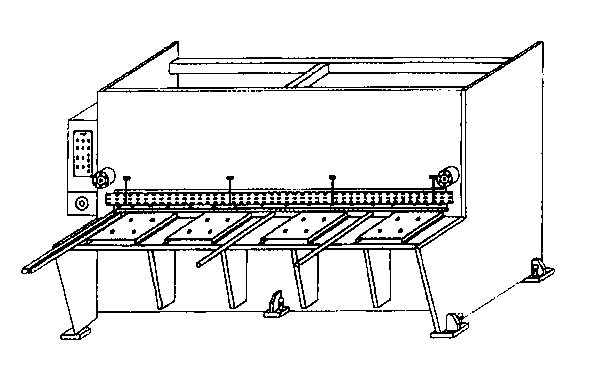
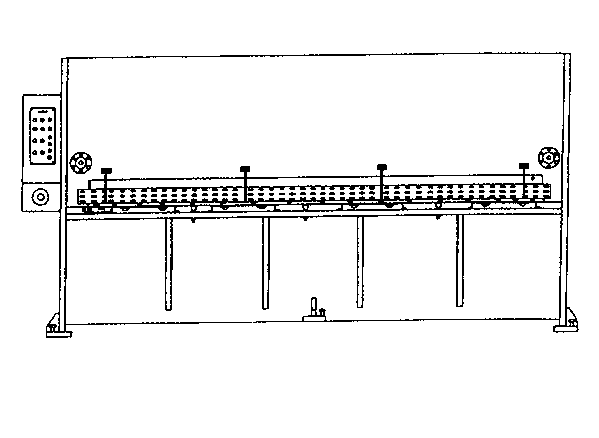
(A) FRONT VIEW
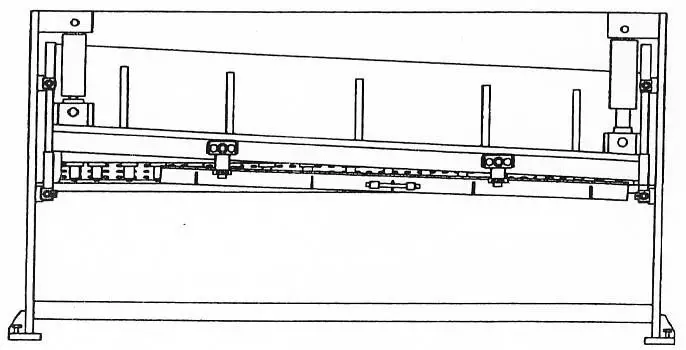
( B ) REAR VIEW
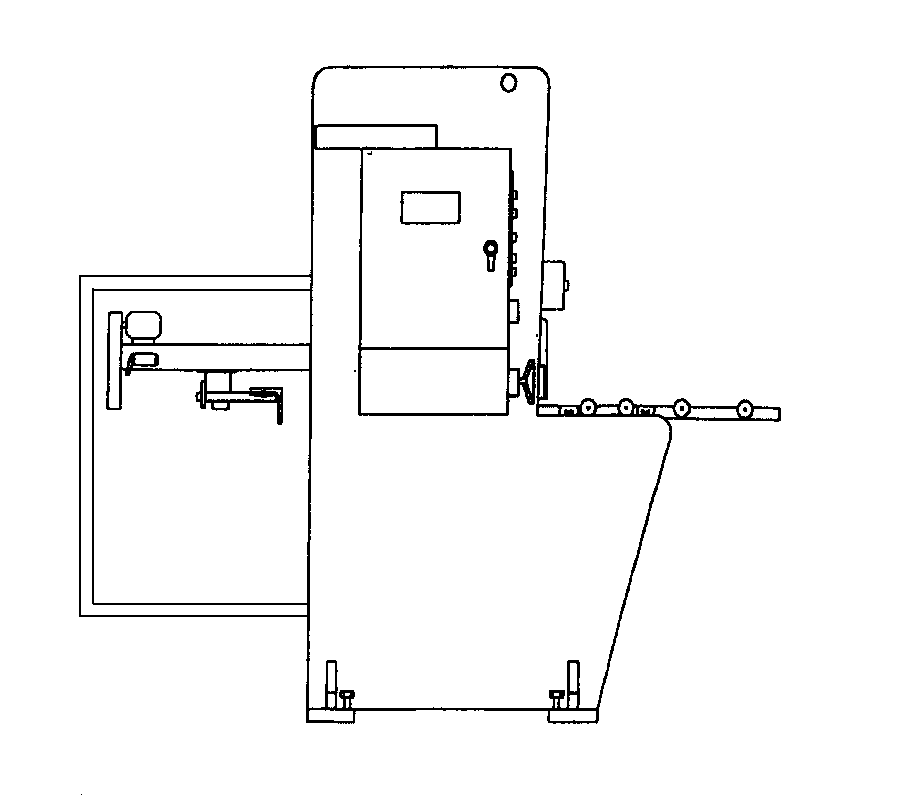
WITH ME IN SIGHT
LI F T EU NG hydraulic guillotine cutting machine
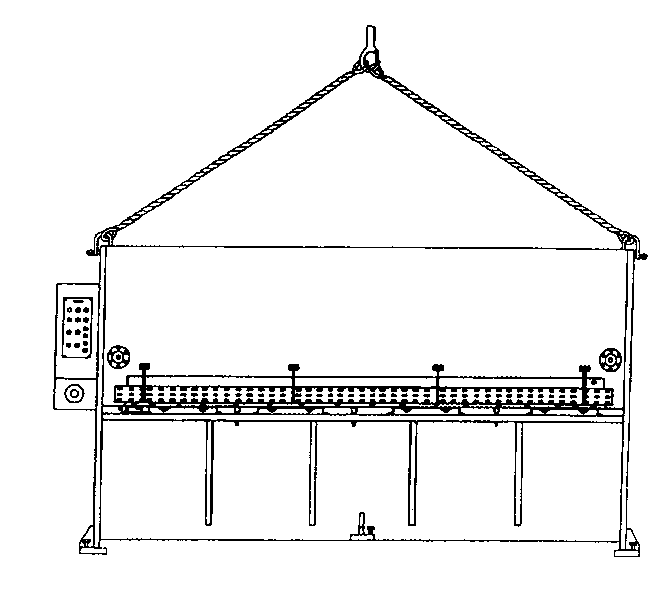
P i ACING OF THE LEVELING GAUGE
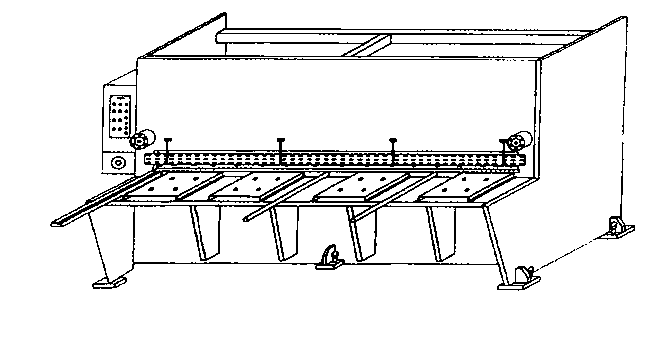
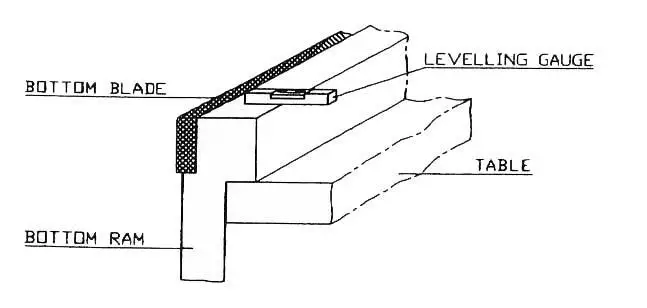
NOTE: Make sure the level gauge is not in contact with the blade and place it as indicated above.
GUILLOTINE SCISSORS SET
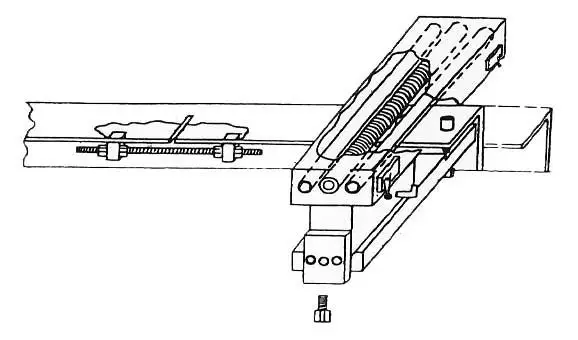
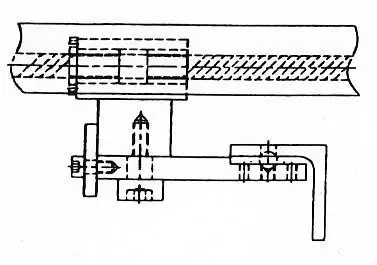
WITH ME IN SIGHT

REAR VIEW
> Check the operation manual of the hydraulic swing beam cutting machine
























































